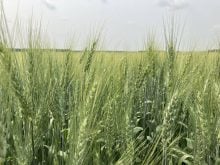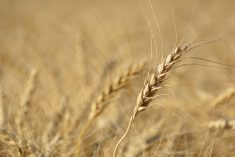Durum seed is a hot commodity in the U.S. northern tier states as American farmers scramble to plant the well-subsidized crop.But that’s the only part of the world in which durum is hot, because good weather in North Africa has swollen production there.”They’re planting it like crazy because of the loan rate,” said Joe Victor of Allendale, Inc. of McHenry, Illinois, about farmers in North Dakota and Montana. “If we can find the seed, we’re planting it.”That’s in marked contrast to most Canadian prairie producers, who see the crop as a money loser this year. The May Canadian Wheat Board Pool Return Outlook for 2010-11 raised durum values by about $5 per tonne for most qualities, but values at port are still less than $195 per tonne and higher grades are down by about $5 to $10 per tonne from the 2009-10 PRO.The CWB forecasts world durum stocks at the start of the 2010-11 crop year will be down by 15 percent, but the stocks and the new crop together, estimated at about 40 million tonnes, will still create a supply glut. The situation isn’t helped by the U.S. loan rate subsidy for durum, which was boosted by $2 per bushel this year in spite of the price outlook.That puzzles analysts like Victor.”I’ve asked them and I’m not getting a straight answer,” he said of loan rate officials.That will likely produce a 12 percent increase in U.S. durum acreage, the wheat board estimates, which will hold the North American production decline to 2.3 million tonnes. North American stocks at the end of 2010-11 are expected to decline by 700,000 tonnes.Durum growing conditions are excellent in North Africa and good in Europe. That means North Africa will be able to provide much of its needs domestically and will need to import less foreign grain, said Bruce Burnett of the CWB.”The domestic production in North Africa looks pretty solid for the second or third year in a row,” said Burnett. North Africa is usually a major durum importing region,If the region needs to import durum, it will have good supplies nearby in Europe, where grain prices are becoming more attractive to buyers because of the decline of the euro currency.Recently, Algeria said that its production prospects have improved so much that it will become a regular exporter of barley, rather than a consistent importer.Burnett is skeptical of Algerian claims of long-term surplus grain production.”It just tells me how much better their weather has been,” said Burnett. “After their next drought, they can get back to me about their exports.”
Read Also

Gap in emission regulations hamstrings Canadian hybrid truck manufacturer
A B.C. company building hybrid engines for heavy trucks says they have the opportunity to build something leading edge in Canada, but our own laws are stopping them from doing it.















